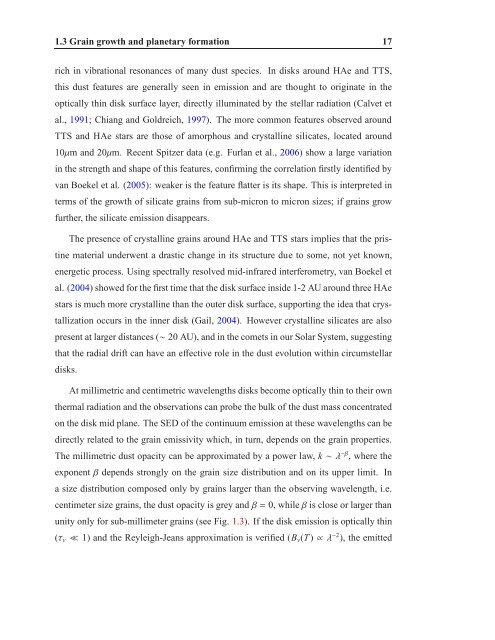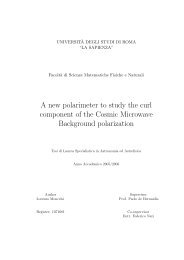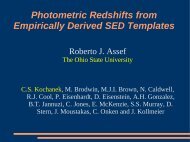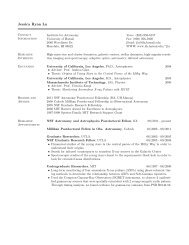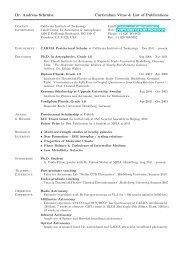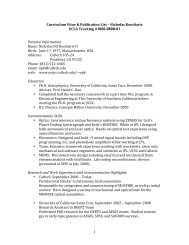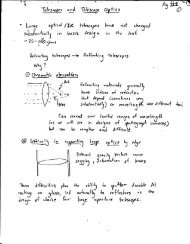Interferometric observations of pre-main sequence disks - Caltech ...
Interferometric observations of pre-main sequence disks - Caltech ...
Interferometric observations of pre-main sequence disks - Caltech ...
You also want an ePaper? Increase the reach of your titles
YUMPU automatically turns print PDFs into web optimized ePapers that Google loves.
1.3 Grain growth and planetary formation 17<br />
rich in vibrational resonances <strong>of</strong> many dust species. In <strong>disks</strong> around HAe and TTS,<br />
this dust features are generally seen in emission and are thought to originate in the<br />
optically thin disk surface layer, directly illuminated by the stellar radiation (Calvet et<br />
al., 1991; Chiang and Goldreich, 1997). The more common features observed around<br />
TTS and HAe stars are those <strong>of</strong> amorphous and crystalline silicates, located around<br />
10µm and 20µm. Recent Spitzer data (e.g. Furlan et al., 2006) show a large variation<br />
in the strength and shape <strong>of</strong> this features, confirming the correlation firstly identified by<br />
van Boekel et al. (2005): weaker is the feature flatter is its shape. This is inter<strong>pre</strong>ted in<br />
terms <strong>of</strong> the growth <strong>of</strong> silicate grains from sub-micron to micron sizes; if grains grow<br />
further, the silicate emission disappears.<br />
The <strong>pre</strong>sence <strong>of</strong> crystalline grains around HAe and TTS stars implies that the pris-<br />
tine material underwent a drastic change in its structure due to some, not yet known,<br />
energetic process. Using spectrally resolved mid-infrared interferometry, van Boekel et<br />
al. (2004) showed for the first time that the disk surface inside 1-2 AU around three HAe<br />
stars is much more crystalline than the outer disk surface, supporting the idea that crys-<br />
tallization occurs in the inner disk (Gail, 2004). However crystalline silicates are also<br />
<strong>pre</strong>sent at larger distances (∼ 20 AU), and in the comets in our Solar System, suggesting<br />
that the radial drift can have an effective role in the dust evolution within circumstellar<br />
<strong>disks</strong>.<br />
At millimetric and centimetric wavelengths <strong>disks</strong> become optically thin to their own<br />
thermal radiation and the <strong>observations</strong> can probe the bulk <strong>of</strong> the dust mass concentrated<br />
on the disk mid plane. The SED <strong>of</strong> the continuum emission at these wavelengths can be<br />
directly related to the grain emissivity which, in turn, depends on the grain properties.<br />
The millimetric dust opacity can be approximated by a power law, k∼λ −β , where the<br />
exponentβdepends strongly on the grain size distribution and on its upper limit. In<br />
a size distribution composed only by grains larger than the observing wavelength, i.e.<br />
centimeter size grains, the dust opacity is grey andβ=0, whileβis close or larger than<br />
unity only for sub-millimeter grains (see Fig. 1.3). If the disk emission is optically thin<br />
(τν≪1) and the Reyleigh-Jeans approximation is verified (Bν(T)∝λ −2 ), the emitted


